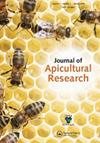夏季室内女王银行作为户外女王银行业务的替代方案
IF 1.8
4区 农林科学
Q2 ENTOMOLOGY
引用次数: 1
摘要
摘要蜂后是复杂的社会中最挑剔的个体。蜂王库是将蜂王单独存放在笼子里,放在一个由工蜂照顾的群体中。随着夏季季节性需求的减少,蜂王生产商将多余的蜂王储存起来,为养蜂人提供按需供应。然而,这种方法可能会受到野火、饲料供应减少和气候变化的威胁。在这项研究中,我们将加州北部目前的夏季户外女王银行业务与室内温控存储设施中的银行业务进行了比较,以调查室内存储作为夏季户外存储替代方案的有效性。治疗分为三组:室内女王银行、室外女王银行和一组无银行对照女王,提供三种不同的放养率(每银行50、100和198女王)。使用实验室和现场评估方法评估女王的质量参数和生存数据。我们发现,除了以100的利率存入银行的室内王后的重量外,王后质量参数没有显著差异,这明显低于其他银行利率。储存在室内的皇后的存活率明显更高,为78 ± 比室外储存的女王高1%,存活率为62 ± 3%。与室外女王银行相比,室内银行在质量和生存方面表现更好。因此,女王银行有可能缓解夏季高温上升造成的宝贵秋季女王供应。图形摘要本文章由计算机程序翻译,如有差异,请以英文原文为准。
Summer indoor queen banking as an alternative to outdoor queen banking practices
Abstract Honey bee queens are the most critical individuals of a complex eusocial society. Queen banking is the storage of queens individually in cages and placed in a colony to be cared for by worker bees. Queen producers bank excess queens as seasonal demand subsides in the summer to provide an on-demand supply to beekeepers. This approach, however, might be threatened by wildfires, decreased forage availability, and climate change. For this study, we compared current summer outdoor queen banking practices in northern California with banking in indoor temperature-controlled storage facilities to investigate the effectiveness of indoor storage as an alternative to outdoor storage in the summer. Treatments were separated into three groups: indoor queen banks, outdoor queen banks, and a set of unbanked control queens provided with three different stocking rates (50, 100, and 198 queens per bank). Queen quality parameters and survival data were assessed using laboratory and field assessment methods. We found no significant difference in queen quality parameters apart from the weight of indoor queens banked at the rate of 100, which were significantly lower than the other banking rates. Queens stored indoors had a significantly higher survival of 78 ± 1% than queens stored outdoors with a survival of 62 ± 3%. Indoor banking performed better in quality and survival as compared to outdoor queen banking. Therefore, queen banking has the potential to mitigate the valuable fall queen supply caused by rising hot summer temperatures. GRAPHICAL ABSTRACT
求助全文
通过发布文献求助,成功后即可免费获取论文全文。
去求助
来源期刊
CiteScore
4.80
自引率
10.50%
发文量
111
审稿时长
6-12 weeks
期刊介绍:
The Journal of Apicultural Research is a refereed scientific journal dedicated to bringing the best research on bees. The Journal of Apicultural Research publishes original research articles, original theoretical papers, notes, comments and authoritative reviews on scientific aspects of the biology, ecology, natural history, conservation and culture of all types of bee (superfamily Apoidea).

 求助内容:
求助内容: 应助结果提醒方式:
应助结果提醒方式:


